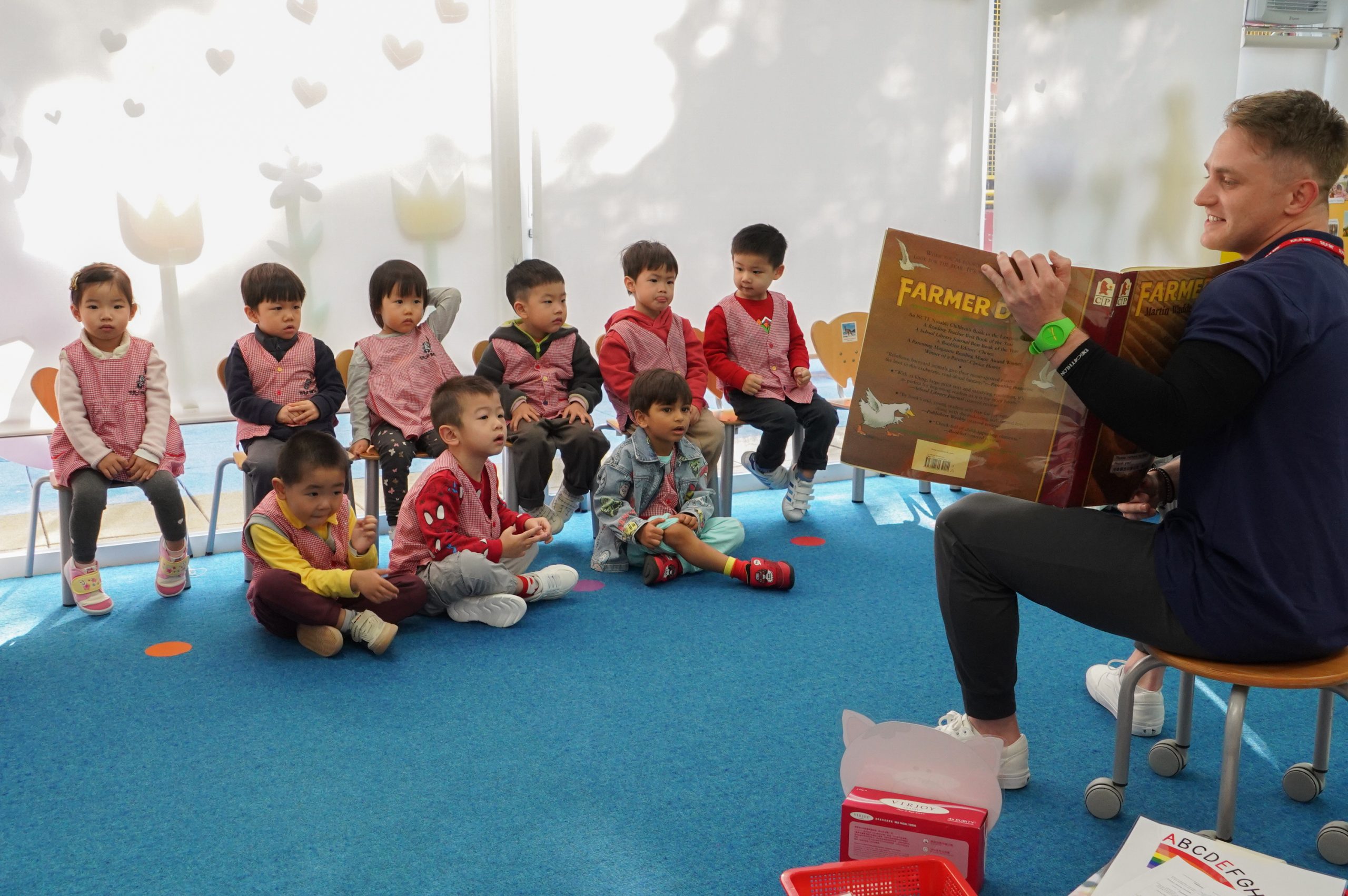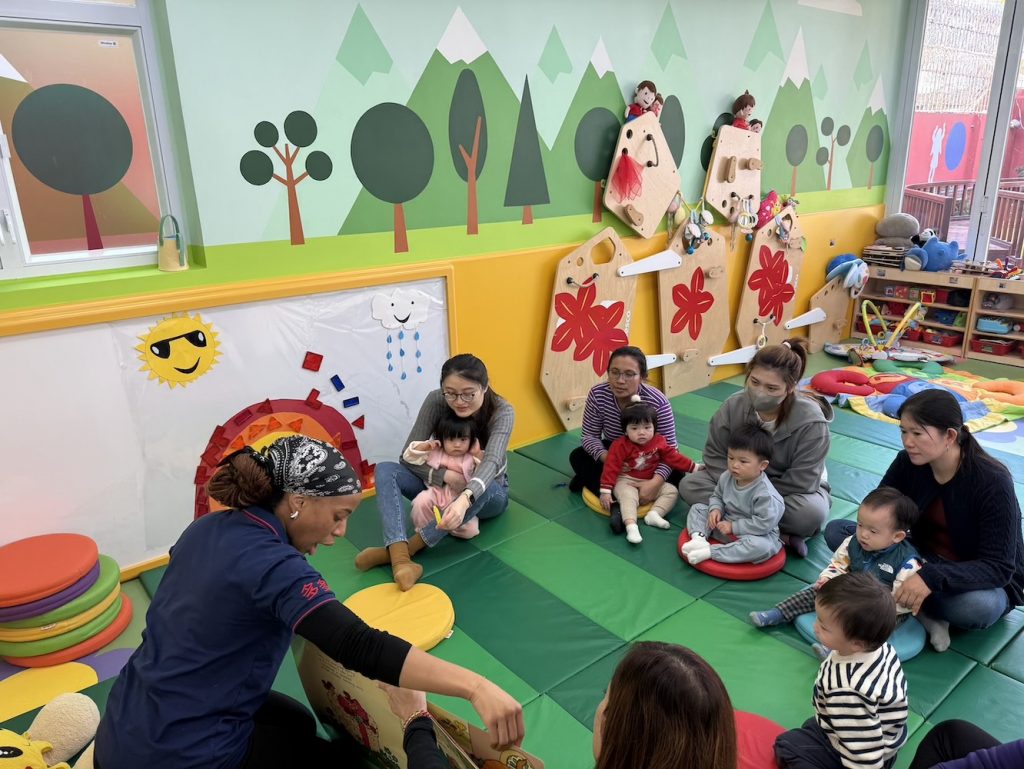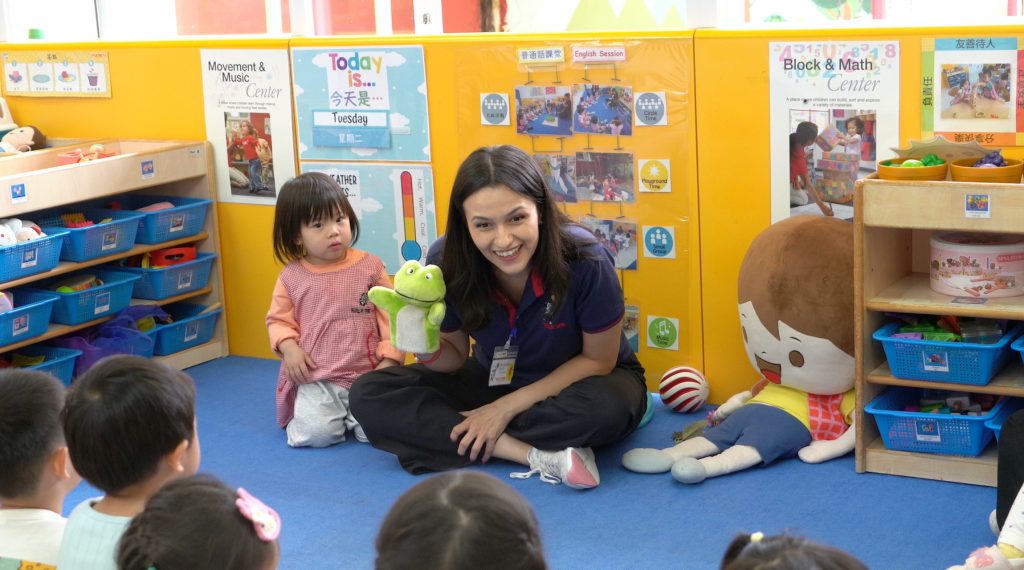One of the most fascinating things about children’s development is how quickly they can pick up languages. At birth, newborn babies can only cry and make simple vowel sounds like ‘oo’ and ‘ah’. By their first year, many babies will say their first word. And from that point onwards, their language skills develop at an exponential rate, from learning new vocabulary and understanding grammatical rules to reading and writing in preschool. Understanding what kind of language development milestones to expect during your child’s preschool years can help you maximise your child’s language learning potential and provide insights on your child’s overall development.
Language development milestones (0 to 1 years old)
Cooing sounds
During your child’s first year of life, they are constantly absorbing the languages around them. At just 2 months old, your baby will begin to make cooing sounds. This is usually an extended vowel sound like ‘oo’, ‘ah’, ‘ee’ and so on.
Laughter
By around 4 months old, your baby will begin to laugh in response to things that happen around them. For example, when you play peek-a-boo, or when they hear an interesting sound.
Babbling sounds
By around 6 months old, your baby will begin to babble using consonant sounds, such as ‘baba’, ‘mama’, ‘googoo’ and so on. Some parents may mistake sounds like ‘mama’ to be their baby’s first word, but at this stage, it’s most likely just a coincidence.
Increased vocalization
By 12 months, your baby will be able to understand simple words like ‘no’. Their babbling may transform into baby jargon or ‘nonsense speech’, and they will vocalize more than before.
Language development milestones (1 to 2 years old)
Preverbal communication
By 12 to 18 months, your toddler’s language development will become more apparent. They will likely begin to combine preverbal communication (gestures and pointing) with simple words to let you know what they want. This period of time is usually when children say their first words.
Vocabulary expansion and comprehension
At around 18 months, your toddler will experience a boost in their vocabulary, and will be able to say anywhere between 20 to 100 words. However, they can usually understand much more than they can say, such as simple directions like “time for bed” and simple explanations like “it’s cold so we need our jackets”.
Sentence development and grammar
By 2 years old, your toddler’s vocabulary will have doubled, and they will be able to say simple 2-to-3-word phrases like “all done” or “more milk”. They may also begin to use adjectives to describe things like “big dog” or “red ball”.
Language development milestones (2 to 3 years old)
Longer sentences and more complex structures
As your toddler enters their third year, you can expect significant progress in their language development. Their sentences will start to get longer as they string 3 or more words together like “mommy is sleeping” and “I want milk”.
Understanding plurals, prepositions, and pronouns
At this age, you’ll begin to hear more complex grammar like the use of prepositions and pronouns, such as “I’m going to sleep” instead of “me sleep”. You’ll also begin to hear your child use plurals like ‘cats’ or ‘balls’.
Retelling stories and making predictions
If you’ve already been reading storybooks with your child, you might realize they are beginning to retell familiar stories and make predictions about what will happen. And don’t worry if your child loves to hear the same stories over and over again – repetition is key for language learning at this age.
Engaging in conversations with peers
As your child’s language skills improve, they will enjoy engaging in back-and-forth conversations with you. For example, they might say something like “I go playground today”. And then in response, you could say “What did you do in the playground?” Through these conversations, your child can learn new language rules while picking up on social cues.
Language development milestones (3 to 4 years old)
Using language for problem-solving and reasoning
As your child gets older, their problem-solving and reasoning skills will also improve. They might begin to voice their problem-solving and reasoning thought processes out loud, such as “if I push the tower, it will fall”. They will also be able to understand more complex explanations and reasoning, such as “if you leave the ice out, it will melt and turn into water”. Expect them to also ask a lot of follow up questions about how things work and why!
Understanding and applying grammatical rules
By age 3, your child will understand and apply basic grammar rules. For example, they will probably use possessive pronouns like “mine”, “yours”, “his”, and “hers”. They will also continue to learn to use plurals and past tense verbs properly. However, keep in mind that they might not always get it right, especially with words that don’t follow traditional rules. Some examples include saying ‘tooths’ instead of ‘teeth’, or ‘runned’ instead of ‘ran’.
Creating detailed and coherent narratives
Your child will enjoy telling stories about what happened during the day along with made up stories. Their stories will have a clear beginning, middle, and end, but sometimes you’ll need to support them by asking follow up questions like “what happened afterwards?”
Understanding social norms and conflict resolution
Your child’s language development is closely tied to their social-emotional development too. As they begin to understand social norms and behaviors, they will use “please” and “thank you” appropriately, use words to express their thoughts and feelings, and even try to resolve conflicts without resorting to physical actions.
Language development milestones (4 to 5 years old)
Using words to explain ideas and express creativity
At this stage, your child will have enough vocabulary to explain more complex ideas, and use their imagination to create stories. For example, if they are learning about plants at school, they might explain “first you put the seed in soil, then you give it water and sun, then it becomes a flower.” They might add on using their imagination something like “I want to plant a forest full of candy!”
Applying grammar rules with accuracy
Your child is beginning to understand and apply more complex grammatical rules accurately. For example, you might notice them combining sentences with ‘and’ or ‘then’ to convey more complex ideas. They will also get better at using the correct past tense form of verbs and irregular plural nouns like “leaves” instead of “leafs”.
Using language to evoke emotions and imagery
As your child’s language skills improve, so do their social and emotional skills. They will be able to use words to express more complex emotions beyond just “happy” and “sad”. They might express feelings like “frustrated”, “confused”, “jealous”, and so on. They might even use simple figures of speech like “raining cats and dogs”.
Active listening and responding appropriately
At this age, your child’s attention span will be much more developed than before, allowing them to better listen and follow directions. They will also understand the natural flow of conversations better and will understand the concept of taking turns to speak. During a conversation, they will be able to stay on topic and add their own thoughts. For example, if you are talking about outer space, they might say “I think there are aliens in space”.
Tips for supporting language development in children
Your child’s language development isn’t only determined by what they learned at school. In fact, children learn much more from their parents and people around them. Here are some activities you can try to support their language development at home.
Create a language rich environment
Whether you choose to raise your child in a monolingual or multilingual household, it’s important to immerse them in a high-quality language environment. This means taking every opportunity to talk, interact, and engage your child, such as through asking questions, narrating what you’re doing, encouraging them to share their thoughts and feelings, and using language during play.
Reading aloud and storytelling
The importance of reading and storytelling should never be underestimated, especially during early childhood. Even if your child is not yet able to fully comprehend what you are saying, reading storybooks from an early age allows your child to develop good reading habits, learn proper pronunciation, pick up on grammatical rules, and much more.
Encouraging play-based language activities
Language activities don’t have to be limited to flashcards and workbooks. You can create language activities from anything at home, such as role-playing a grocery shopping experience, using kitchen utensils as instruments and creating a band, dancing to the alphabet song, and much more.
Limit screen time
Screen time is often a subject of contention, but in general, it’s best to limit screen time whenever possible. Regardless of the possible pros and cons of screen time, one thing is certain: the more time your child spends looking at screens, the less time they spend interacting with people, and the less opportunities they have for learning languages.
Encourage your child to share their thoughts and feelings
As your child becomes more able to express themselves, get them into the habit of sharing their feelings. For example, you can ask “how did you feel when your friend pushed you over?” This not only helps with their language expression skills, it is also crucial for developing their social and emotional skills. You can also model healthy ways to express and cope with feelings by sharing your own experiences with your child too.
Conclusion
Children’s language development is still a marvel that even us educators are trying to understand. From being completely non-verbal at birth to saying sentences (sometimes in multiple languages) by 3 years old, children have a unique ability to acquire language and we should do our best to capitalize on this opportunity. While there is no rush to get from one stage to the next, it is important to keep an eye out for any potential delays in hearing and speech. As caregivers, you play a crucial role in your child’s language development. Remember to try some of the suggestions above to actively support your child’s language development at home!
References:
https://raisingchildren.net.au/toddlers/development/language-development/language-1-2-years
https://raisingchildren.net.au/toddlers/development/language-development/language-2-3-years
https://raisingchildren.net.au/preschoolers/development/language-development/language-3-4-years
https://raisingchildren.net.au/preschoolers/development/language-development/language-4-5-years



